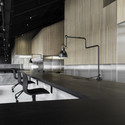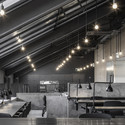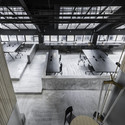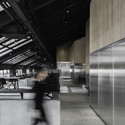
-
Architects: Neri&Hu Design and Research Office
- Area: 620 m²
- Year: 2014
-
Photographs:Dirk Weiblen
Text description provided by the architects. In Gaston Bachelard’s seminal work The Poetics of Space he poses a metaphor of the house as a dwelling for the psyche; while the subterranean cellar represents our deep subconscious, the elevated attic is a space of quiet and rational thought. In our imaginations and memories, the attic is an oft forgotten space, a space of contradictions and possibilities, both dark and light, intimate and vast, daunting and comforting. Neri&Hu’s renovation of an industrial roof space in Shanghai into offices for a leading global insight and strategic consultancy Flamingo are inspired by these very paradoxical and enigmatic notions of the attic.























.jpg?1403914671)
.jpg?1403914729)
.jpg?1403914716)


.jpg?1403914638)
.jpg?1403914637)